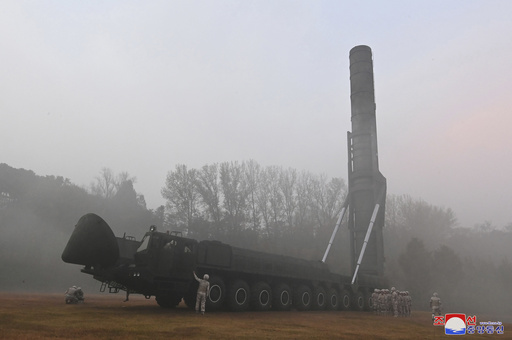
SEOUL, South Korea — On Friday, North Korea proudly announced its latest intercontinental ballistic missile (ICBM), claiming it to be “the world’s strongest.” Experts outside the country view this assertion as mere propaganda, but the recent test indicates notable advancements in North Korea’s ambition to construct a more dependable arsenal of weapons.
The missile launched by North Korea on Thursday achieved unprecedented heights and remained airborne longer than any prior missile, suggesting advancements toward developing a nuclear-capable ICBM capable of striking the U.S. mainland. However, analysts from other countries believe that North Korea still faces several technological hurdles before it can effectively utilize such a missile.
The missile has been identified by North Korea’s Korean Central News Agency as the “Hwasong-19” ICBM, referred to as “the world’s strongest strategic missile” and “the perfected weapon system.” During the launch, North Korean leader Kim Jong Un was present and labeled the test as “an appropriate military action,” emphasizing North Korea’s determination to respond to perceived escalating threats to its security. Kim expressed gratitude to weapon scientists for showcasing the nation’s “matchless strategic nuclear attack capability.”
Earlier reports from South Korea’s military suggested that North Korea may have tested a missile powered by solid fuel. However, the recent KCNA report did not specify the type of propellant used for the Hwasong-19 ICBM. Observers remark that the coloration of the exhaust flames seen in media portrayals after the launch indicates that the missile likely operates using solid fuels.
Before Thursday’s test, North Korea’s most advanced missile was recognized as the “Hwasong-18,” which is also solid-fueled. Missiles employing pre-loaded solid propellants are more mobile and drastically reduce the time needed for launch preparations compared to liquid-fueled missiles, which have to be filled with propellant before being launched. This characteristic makes solid-fuel missiles more challenging for adversaries to detect during launches.
In recent times, North Korea has claimed ongoing progress in developing nuclear-capable missiles. Many international experts are convinced that North Korea possesses the means to deliver nuclear strikes across all of South Korea; however, it has yet to create a missile system with the range to reach the U.S. mainland.
Critical questions remain regarding North Korea’s capabilities to protect its warheads during re-entry into the atmosphere, which involves managing extreme heat and pressure. Many analysts indicate that improvements in guidance and altitude control systems are necessary for North Korea, as is the ability to deploy multiple warheads on a single missile to effectively overcome missile defense systems.
All known ICBM tests from North Korea, including the recent one, have been conducted at steep angles to avoid encroaching on neighboring territories. A representative from South Korea’s military, Lee Sung Joon, stated that launching at a high-angle trajectory does not provide valid data on the missile’s re-entry technology, despite North Korea’s previous claims of having mastered that aspect.
Observers suggest that Thursday’s test, the first ICBM launch in nearly a year, was partially aimed at catching the attention of the U.S. just days prior to the upcoming presidential election and responding to global disapproval over reports of North Korea sending troops to Russia to bolster its efforts in the ongoing conflict with Ukraine.
The reported troop deployment underscores the growing military relationship between North Korea and Russia. Both South Korea and the U.S., along with other nations, are apprehensive that North Korea may seek advanced Russian technology to enhance its nuclear and missile ambitions in exchange for military support in the Russia-Ukraine conflict.
